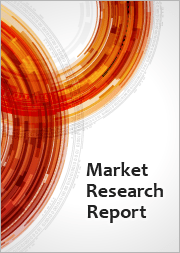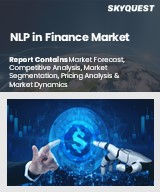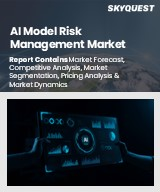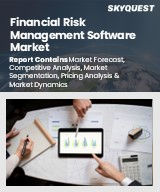
|
시장보고서
상품코드
1511292
세계의 은행 리스크 관리 시스템 시장 : 분석 - 전개별, 기능별, 기업 규모별, 최종사용자별, 지역별, 예측(-2030년)Risk Management Systems in Banks Market Forecasts to 2030 - Global Analysis By Deployment, Functionality, Enterprise Size, End User and by Geography |
||||||
세계 은행 리스크 관리 시스템 시장 규모는 2024년 112억 1,000만 달러에 달하고, 2030년에는 263억 3,000만 달러에 달할 것으로 예측됩니다.
은행에 리스크 관리 시스템이 필요한 이유는 일상 업무의 일부인 다양한 리스크를 인식, 평가 및 줄이기 위해 필수적인 시스템이기 때문입니다. 앞서 언급한 시스템은 은행의 경영 자원을 보존하고, 법규를 준수하며, 경제적 안정성을 보장하기 위해 고안된 다양한 절차, 수단 및 전술로 구성됩니다.
국제통화기금(IMF)에 따르면 효과적인 리스크 관리 시스템은 금융 안정을 유지하고 은행 부문의 지속가능한 경제 성장을 촉진하는 데 필수적입니다.
금융 안정성에 대한 우려
과거의 금융위기, 특히 2008년 세계 금융위기의 영향은 효율적인 리스크 관리가 시스템적 차원의 금융 안정성을 유지하는 데 얼마나 중요한지 강조하고 있습니다. 은행은 강력한 리스크 관리 절차와 스트레스 테스트 기법을 통해 연결성 및 파급효과와 같은 시스템 리스크를 감지하고 감소시켜야 합니다. 또한, 금융시스템의 안정성을 위협할 수 있는 잠재적인 시스템적 충격을 예측하고 이를 완화하기 위해 시나리오 분석, 거시경제 지표 모니터링, 다양한 자산군에 대한 철저한 리스크 평가 등을 포함합니다.
낮은 데이터 접근성 및 품질
정확하고 시기적절한 데이터는 위험을 모델링하고, 노출을 평가하고, 정보에 입각한 의사결정을 내리기 위해 효과적인 리스크 관리에 필수적입니다. 그럼에도 불구하고 은행들은 데이터의 가용성, 완전성, 품질 측면에서 어려움을 겪는 경우가 많습니다. 또한, 불충분한 데이터 품질은 리스크 평가의 신뢰성을 떨어뜨리고, 리스크 관리 방법론의 효율성을 제한하며, 그 결과 의사결정이 이상적이지 않아 리스크 노출을 증가시킬 수 있습니다.
신흥 기술 채택
인공지능(AI), 머신러닝(ML), 빅데이터 분석과 같은 기술의 급속한 발전은 은행의 리스크 관리 숙련도를 향상시킬 수 있는 큰 잠재력을 제공하고 있습니다. AI와 ML 알고리즘을 통해 대량의 데이터를 실시간으로 분석함으로써 은행은 트렌드와 이상 징후를 발견하고 발생할 수 있는 위험을 보다 정확하게 예측할 수 있습니다. 또한 빅데이터 분석은 소비자 행동, 시장 동향 및 위험 노출에 대한 심층적인 인사이트를 제공함으로써 은행이 데이터 기반 의사결정을 내리고 보다 강력한 위험 완화 계획을 수립할 수 있도록 돕습니다.
시장 변동성과 경제의 불확실성
은행들은 금융시장 변동성, 경기침체, 지정학적 사건으로 인해 시장 리스크, 신용 리스크, 유동성 리스크 관리의 어려움에 직면하고 있습니다. 시장 변동성은 자산 가격 변동, 자금 조달 제약, 거래 상대방의 신용 위험에 대한 노출 변화를 유발하여 수익성과 자기자본비율에 영향을 미칠 수 있습니다. 또한, 시스템 리스크는 금융의 회복력을 약화시키는 지정학적 불안과 경제의 불확실성으로 인해 악화될 수 있습니다. 불리한 시장 환경의 영향을 완화하고 시스템 리스크로부터 보호하기 위해 은행은 강력한 리스크 관리 전략, 스트레스 테스트 절차 및 시나리오 분석 기법을 도입해야 합니다.
COVID-19의 영향:
COVID-19 팬데믹은 업무상의 어려움, 규제 조치, 경제 혼란 등 은행산업에 큰 혼란을 가져왔습니다. 봉쇄 조치, 공급망 중단, 불확실성 증가로 인해 경제 활동 감소, 신용 위험 증가, 시장 변동성 증가가 발생했습니다. 부실채권 증가, 마진 축소, 유동성 제약으로 인해 은행들은 현재 손실을 흡수하기 위해 더 큰 자본 완충액과 충당금을 필요로 하고 있습니다. 또한, 디지털 전환과 원격 근무의 증가로 인해 사이버 보안과 기술 복원력의 중요성이 강조되고 있습니다.
예측 기간 동안 리스크 모니터링 부문이 가장 큰 비중을 차지할 것으로 예상
리스크 모니터링이 가장 큰 시장 점유율을 차지할 것으로 예상됩니다. 리스크 모니터링은 신용 리스크, 시장 리스크, 유동성 리스크, 운영 규정 준수 리스크 등 다양한 리스크 카테고리를 지속적으로 관찰하고 추적하는 것을 포함합니다. 또한, 위험 선호도 임계치에서 벗어나는 것을 발견하고 필요한 조치를 취하기 위해 새로운 위험, 조기 경보 징후 및 주요 위험 지표를 실시간으로 모니터링하는 것도 포함됩니다. 데이터 분석, 머신러닝 알고리즘, 대시보드 시각화 툴을 활용하는 고급 리스크 모니터링 시스템은 은행이 리스크 노출에 대한 인사이트를 적시에 제공함으로써 리스크와 수익의 절충점을 최적화하고 선제적으로 리스크를 관리할 수 있도록 돕습니다. 관리할 수 있도록 지원합니다.
예측 기간 동안 BFSI 부문이 가장 높은 CAGR을 기록할 것으로 예상
은행 리스크 관리 시스템 시장에서 은행, 금융 서비스 및 보험(BFSI) 산업은 신용 리스크, 시장 리스크, 유동성 리스크, 운영 리스크, 규제 리스크 등 복잡하고 역동적인 리스크 환경에 직면해 있어 금융 안정성을 보호하고 규제 준수를 보장하기 위해 강력한 리스크 관리 프레임워크가 필요합니다. 금융 안정성을 지키고 규제 준수를 보장하기 위해서는 강력한 리스크 관리 프레임워크가 필요합니다. 또한, 은행들은 은행 서비스의 디지털화, 사이버 위협, 규제 당국의 감독에 대응하기 위해 리스크 식별, 평가, 완화 및 모니터링 능력을 향상시키는 첨단 리스크 관리 시스템에 투자하고 있습니다.
가장 높은 점유율을 차지하는 지역:
은행 리스크 관리 시스템 시장에서는 일반적으로 북미가 가장 큰 점유율을 차지하고 있습니다. 북미는 은행 부문이 발달한 지역으로, 엄격한 법적 규제, 첨단 리스크 관리 기술, 첨단 기술의 보급이 특징입니다. 이 지역의 은행들이 강력한 리스크 관리 솔루션을 필요로 하는 배경에는 중요한 은행 거점, 엄격한 규제 감독, 사이버 보안에 대한 관심 증가 등의 요인이 있습니다. 또한, 이 지역의 핀테크 생태계의 번영과 혁신 및 디지털 전환에 대한 강조로 인해 첨단 리스크 관리 기술에 대한 투자가 활발히 이루어지고 있습니다.
CAGR이 가장 높은 지역:
은행 리스크 관리 시스템 시장의 CAGR이 가장 높은 지역은 유럽 지역입니다. 유럽은 기존 금융기관과 도전적인 은행이 모두 존재하는 다양한 은행 환경에 직면해 있습니다. 또한 사이버 보안 위협의 증가, 디지털 전환의 필요성, 진화하는 규제 요건에 직면해 있습니다. 금융 안정성을 유지하고, 바젤 III와 같은 엄격한 규제 요건을 준수하고, 사이버 범죄 및 데이터 프라이버시 문제와 같은 새로운 위험에 대응하기 위해 유럽 은행들은 리스크 관리를 최우선 과제로 삼고 있습니다. 또한, 이 지역이 지속가능한 금융과 환경, 사회, 지배구조(ESG)에 대한 중요성을 강조하면서 창의적인 리스크 관리 전략을 채택하고 있습니다.
목차
제1장 주요 요약
제2장 서문
- 개요
- 이해관계자
- 조사 범위
- 조사 방법
- 데이터 마이닝
- 데이터 분석
- 데이터 검증
- 조사 접근법
- 조사 정보 출처
- 1차 조사 정보 출처
- 2차 조사 정보 출처
- 가정
제3장 시장 동향 분석
- 성장 촉진요인
- 성장 억제요인
- 기회
- 위협
- 최종사용자 분석
- 신흥 시장
- COVID-19의 영향
제4장 Porter's Five Forces 분석
- 공급 기업의 교섭력
- 구매자의 교섭력
- 대체품의 위협
- 신규 참여업체의 위협
- 경쟁 기업 간의 경쟁 관계
제5장 세계의 은행 리스크 관리 시스템 시장 : 전개별
- 온프레미스
- 클라우드
- 퍼블릭 클라우드
- 프라이빗 클라우드
- 하이브리드 클라우드
- 기타 전개
제6장 세계의 은행 리스크 관리 시스템 시장 : 기능별
- 리스크 특정
- 리스크 평가
- 리스크 경감
- 리스크 감시
- 기타 기능
제7장 세계의 은행 리스크 관리 시스템 시장 : 기업 규모별
- 중소기업
- 대기업
제8장 세계의 은행 리스크 관리 시스템 시장 : 최종사용자별
- BFSI
- 헬스케어
- 소매
- IT·통신
- 정부
- 기타 최종사용자
제9장 세계의 은행 리스크 관리 시스템 시장 : 지역별
- 북미
- 미국
- 캐나다
- 멕시코
- 유럽
- 독일
- 영국
- 이탈리아
- 프랑스
- 스페인
- 기타 유럽
- 아시아태평양
- 일본
- 중국
- 인도
- 호주
- 뉴질랜드
- 한국
- 기타 아시아태평양
- 남미
- 아르헨티나
- 브라질
- 칠레
- 기타 남미
- 중동 및 아프리카
- 사우디아라비아
- 아랍에미리트
- 카타르
- 남아프리카공화국
- 기타 중동 및 아프리카
제10장 주요 발전
- 계약, 파트너십, 협업, 합작투자
- 인수와 합병
- 신제품 발매
- 사업 확대
- 기타 주요 전략
제11장 기업 개요
- Palisade Corporation
- Fiserv Inc.
- LogicManager Inc
- Moody's Investors Service Inc.
- International Business Machines(IBM)
- Oracle
- Lockpath Inc.
- Sword GRC
- Xactium
- IBM Risk Analytics
- Qualys Inc
According to Stratistics MRC, the Global Risk Management Systems in Banks Market is accounted for $11.21 billion in 2024 and is expected to reach $26.33 billion by 2030 growing at a CAGR of 15.3% during the forecast period. Banks need risk management systems because they are essential structures meant to recognize, evaluate, and reduce the many kinds of risks that are part of their daily business. The aforementioned systems comprise an assortment of procedures, instruments, and tactics designed to preserve the bank's resources, uphold legal observance, and guarantee economic steadiness.
According to the International Monetary Fund (IMF), Effective risk management systems are essential for maintaining financial stability and promoting sustainable economic growth in the banking sector.
Market Dynamics:
Driver:
Concerns about financial stability
The fallout from previous financial crises, most notably the global financial crisis of 2008, emphasizes how crucial efficient risk management is to preserving financial stability on a systemic level. Banks must use strong risk management procedures and stress testing techniques to detect and reduce systemic risks, such as connectivity and spillover effects. Additionally, this includes scenario analysis, macroeconomic indicator monitoring, and thorough risk assessment across a range of asset classes in order to foresee and reduce potential systemic shocks that might jeopardize the stability of the financial system.
Restraint:
Low data accessibility and quality
Accurate and timely data is essential for effective risk management in order to model risks, evaluate exposures, and make well-informed decisions. Nonetheless, banks frequently face difficulties with data availability, completeness, and quality, particularly when working with different data sources and outdated systems. Furthermore, inadequate data quality can compromise risk assessments dependability and restrict the efficacy of risk management techniques, resulting in less-than-ideal decision-making and heightened risk exposure.
Opportunity:
Adoption of emerging technologies
The swift progression of technologies like artificial intelligence (AI), machine learning (ML), and big data analytics offers banks substantial prospects to improve their risk management proficiencies. Large volumes of data can be analyzed in real time by AI and an ML algorithm, which helps banks find trends, spot abnormalities, and more accurately forecast possible risks. Moreover, big data analytics helps banks make data-driven decisions and create more potent risk mitigation plans by offering deeper insights into consumer behavior, market trends, and risk exposures.
Threat:
Volatility of the markets and economic uncertainties
Banks face difficulties in managing market, credit, and liquidity risks due to fluctuations in financial markets, economic downturns, and geopolitical events. Market volatility can affect profitability and capital adequacy by causing changes in asset prices, funding limitations, and exposure to counterparty credit risk. Furthermore, systemic risks can be made worse by geopolitical unrest and economic uncertainty, which weaken financial resilience. In order to mitigate the effects of unfavorable market conditions and protect against systemic risks, banks need to implement strong risk management strategies, stress testing procedures, and scenario analysis techniques.
Covid-19 Impact:
The COVID-19 pandemic has caused significant disruptions to the banking industry, including operational difficulties, regulatory actions, and economic turmoil. Reduced economic activity, elevated credit risks, and increased market volatility have resulted from lockdown measures, supply chain disruptions, and increased uncertainty. Due to increasing loan losses, margin compression, and liquidity constraints, banks now need larger capital buffers and provisions to absorb losses. Additionally, the rise in digital transformation initiatives and remote work arrangements emphasizes the significance of cyber security and technology resilience.
The Risk Monitoring segment is expected to be the largest during the forecast period
It is projected that risk monitoring will command the largest market share. Risk monitoring entails the ongoing observation and tracking of multiple risk categories, such as credit, market, liquidity, operational, and compliance risks. Moreover, this section includes real-time monitoring of emerging risks, early warning signs, and key risk indicators in order to spot departures from risk appetite thresholds and take the necessary action. By utilizing data analytics, machine learning algorithms, and dashboard visualization tools, advanced risk monitoring systems enable banks to optimize risk-return trade-offs and manage risks proactively by providing timely insights into risk exposures.
The BFSI segment is expected to have the highest CAGR during the forecast period
In the Risk Management Systems in Banks Market, the Banking, Financial Services, and Insurance (BFSI) industry is projected to have the highest CAGR. Strong risk management frameworks are necessary to protect financial stability and guarantee regulatory compliance in the BFSI sector because of the complex and dynamic risk landscapes it faces, which include credit, market, liquidity, operational, and regulatory risks. Additionally, banks are investing in sophisticated risk management systems to improve risk identification, assessment, mitigation, and monitoring capabilities in response to the growing digitization of banking services, cyber threats, and regulatory scrutiny.
Region with largest share:
When it comes to the market for risk management systems in banks, North America usually has the largest share. North America has a well-developed banking sector that is distinguished by strict legal regulations, sophisticated risk management techniques, and the widespread use of cutting-edge technologies. The need for strong risk management solutions among banks in the region is driven by factors like the existence of significant banking hubs, stringent regulatory oversight, and growing cyber security concerns. Furthermore, investments in cutting-edge risk management technologies are fuelled by the region's thriving fintech ecosystem and a strong emphasis on innovation and digital transformation.
Region with highest CAGR:
The European region has the highest CAGR in the risk management systems market for banks. Europe faces a banking landscape that is diverse, with both established institutions and challenger banks. It also faces growing cybersecurity threats, digital transformation imperatives, and evolving regulatory requirements. In order to preserve financial stability, adhere to strict regulatory requirements like Basel III, and handle new risks like cybercrime and data privacy issues, European banks place a high priority on risk management. Moreover, the adoption of creative risk management strategies is fueled by the region's emphasis on sustainable finance and environmental, social, and governance (ESG) considerations.
Key players in the market
Some of the key players in Risk Management Systems in Banks market include Palisade Corporation, Fiserv Inc., LogicManager Inc, Moody's Investors Service Inc., International Business Machines (IBM), Oracle, Lockpath Inc., Sword GRC, Xactium, IBM Risk Analytics and Qualys Inc.
Key Developments:
In December 2023, IBM announced that it has entered into a definitive agreement with Software AG (FRA: SOW), a company majority owned by Silver Lake, to purchase StreamSets and webMethods, Software AG's Super iPaaS (integration platform-as-a-service) enterprise technology platforms, for €2.13 billion in cash.
In August 2023, Fiserv, Inc., a leading global provider of payments and financial services technology, and Akoya, an API-only network for the consumer-permissioned sharing of financial data, are collaborating to enable secure data sharing among financial institutions, their customers, and the third parties with which they do business.
Deployments Covered:
- On-Premise
- Cloud
- Other Deployments
Functionalities Covered:
- Risk Identification
- Risk Assessment
- Risk Mitigation
- Risk Monitoring
- Other Functionalities
Enterprise Sizes Covered:
- Small & Medium Enterprises
- Large Enterprise
End Users Covered:
- BFSI
- Healthcare
- Retail
- IT and Telecommunication
- Government
- Other End Users
Regions Covered:
- North America
- US
- Canada
- Mexico
- Europe
- Germany
- UK
- Italy
- France
- Spain
- Rest of Europe
- Asia Pacific
- Japan
- China
- India
- Australia
- New Zealand
- South Korea
- Rest of Asia Pacific
- South America
- Argentina
- Brazil
- Chile
- Rest of South America
- Middle East & Africa
- Saudi Arabia
- UAE
- Qatar
- South Africa
- Rest of Middle East & Africa
What our report offers:
- Market share assessments for the regional and country-level segments
- Strategic recommendations for the new entrants
- Covers Market data for the years 2022, 2023, 2024, 2026, and 2030
- Market Trends (Drivers, Constraints, Opportunities, Threats, Challenges, Investment Opportunities, and recommendations)
- Strategic recommendations in key business segments based on the market estimations
- Competitive landscaping mapping the key common trends
- Company profiling with detailed strategies, financials, and recent developments
- Supply chain trends mapping the latest technological advancements
Free Customization Offerings:
All the customers of this report will be entitled to receive one of the following free customization options:
- Company Profiling
- Comprehensive profiling of additional market players (up to 3)
- SWOT Analysis of key players (up to 3)
- Regional Segmentation
- Market estimations, Forecasts and CAGR of any prominent country as per the client's interest (Note: Depends on feasibility check)
- Competitive Benchmarking
- Benchmarking of key players based on product portfolio, geographical presence, and strategic alliances
Table of Contents
1 Executive Summary
2 Preface
- 2.1 Abstract
- 2.2 Stake Holders
- 2.3 Research Scope
- 2.4 Research Methodology
- 2.4.1 Data Mining
- 2.4.2 Data Analysis
- 2.4.3 Data Validation
- 2.4.4 Research Approach
- 2.5 Research Sources
- 2.5.1 Primary Research Sources
- 2.5.2 Secondary Research Sources
- 2.5.3 Assumptions
3 Market Trend Analysis
- 3.1 Introduction
- 3.2 Drivers
- 3.3 Restraints
- 3.4 Opportunities
- 3.5 Threats
- 3.6 End User Analysis
- 3.7 Emerging Markets
- 3.8 Impact of Covid-19
4 Porters Five Force Analysis
- 4.1 Bargaining power of suppliers
- 4.2 Bargaining power of buyers
- 4.3 Threat of substitutes
- 4.4 Threat of new entrants
- 4.5 Competitive rivalry
5 Global Risk Management Systems in Banks Market, By Deployment
- 5.1 Introduction
- 5.2 On-Premise
- 5.3 Cloud
- 5.3.1 Public Cloud
- 5.3.2 Private Cloud
- 5.3.3 Hybrid Cloud
- 5.4 Other Deployments
6 Global Risk Management Systems in Banks Market, By Functionality
- 6.1 Introduction
- 6.2 Risk Identification
- 6.3 Risk Assessment
- 6.4 Risk Mitigation
- 6.5 Risk Monitoring
- 6.6 Other Functionalities
7 Global Risk Management Systems in Banks Market, By Enterprise Size
- 7.1 Introduction
- 7.2 Small & Medium Enterprises
- 7.3 Large Enterprise
8 Global Risk Management Systems in Banks Market, By End User
- 8.1 Introduction
- 8.2 BFSI
- 8.3 Healthcare
- 8.4 Retail
- 8.5 IT and Telecommunication
- 8.6 Government
- 8.7 Other End Users
9 Global Risk Management Systems in Banks Market, By Geography
- 9.1 Introduction
- 9.2 North America
- 9.2.1 US
- 9.2.2 Canada
- 9.2.3 Mexico
- 9.3 Europe
- 9.3.1 Germany
- 9.3.2 UK
- 9.3.3 Italy
- 9.3.4 France
- 9.3.5 Spain
- 9.3.6 Rest of Europe
- 9.4 Asia Pacific
- 9.4.1 Japan
- 9.4.2 China
- 9.4.3 India
- 9.4.4 Australia
- 9.4.5 New Zealand
- 9.4.6 South Korea
- 9.4.7 Rest of Asia Pacific
- 9.5 South America
- 9.5.1 Argentina
- 9.5.2 Brazil
- 9.5.3 Chile
- 9.5.4 Rest of South America
- 9.6 Middle East & Africa
- 9.6.1 Saudi Arabia
- 9.6.2 UAE
- 9.6.3 Qatar
- 9.6.4 South Africa
- 9.6.5 Rest of Middle East & Africa
10 Key Developments
- 10.1 Agreements, Partnerships, Collaborations and Joint Ventures
- 10.2 Acquisitions & Mergers
- 10.3 New Product Launch
- 10.4 Expansions
- 10.5 Other Key Strategies
11 Company Profiling
- 11.1 Palisade Corporation
- 11.2 Fiserv Inc.
- 11.3 LogicManager Inc
- 11.4 Moody's Investors Service Inc.
- 11.5 International Business Machines (IBM)
- 11.6 Oracle
- 11.7 Lockpath Inc.
- 11.8 Sword GRC
- 11.9 Xactium
- 11.10 IBM Risk Analytics
- 11.11 Qualys Inc



















